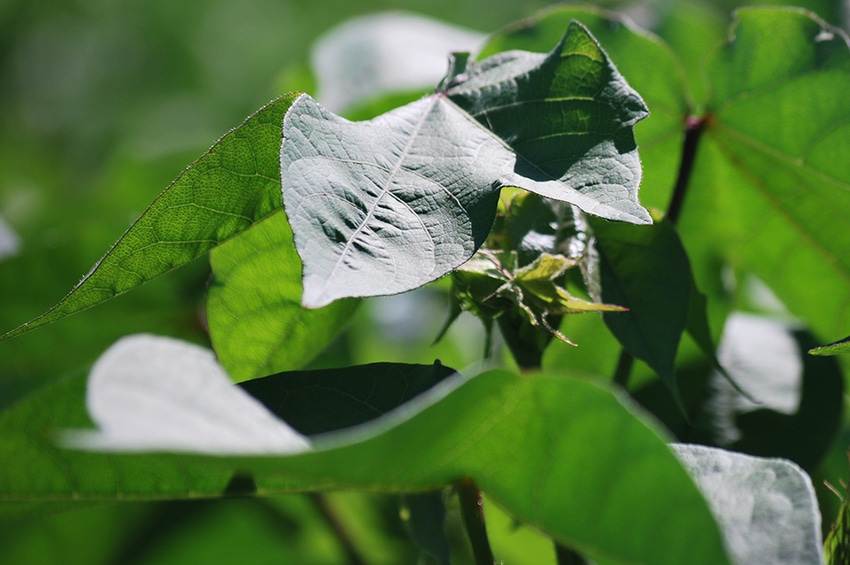
One of them, Stemphylium leaf spot, is likely to be more problematic when hot and dry conditions have prevailed at some point earlier in the season. Target spot is likely to be problematic in fields with good growth and good yield potential and where conditions are warm and humid. Areolate mildew typically appears during the second half of the growing season and, like target spot, is favored by rainfall and humidity.
It is important to be able to differentiate these diseases of cotton because effective management options are different.
Stemphylium
Stemphylium leaf spot is associated with a deficiency in potassium in the cotton plant. This deficiency may occur because the soil is deficient in potassium or because the roots have not been able to translocate sufficient potassium from the soil. This could be the result of drought where water was not available to move the potassium into the plant, or it may occur in areas where plant-parasitic nematodes have damaged the roots and inhibited nutrient uptake.
Severe symptoms of Stemphylium leaf spot often occur in the sandier areas of a field, whether because nutrients are more easily leached from those areas because drought is felt more intensely there, or because sting and root-knot nematodes are more commonly found in sandier areas of a field.
Plants affected by Stemphylium leaf spot show poor growth and significant reddening and yellowing in the foliage. Spots are found on leaves throughout the canopy, and especially at the top of the plant. Centers of the spots are papery and bleached-gray; often having a “shot-hole” appearance. As Stemphylium leaf spot is the result of a potassium deficiency, fungicides are generally ineffective in managing this disease.
Target Spot
Target spot, caused by the fungal pathogen Corynespora cassiicola, is a disease of cotton when the crop has a dense canopy of leaves and high yield potential. Target spot is especially problematic where there are extended periods of leaf wetness, either because of frequent rain showers or where a dense leaf canopy and high humidity reduce airflow and keep leaves in the lower part of the plant from drying.
Target spot can also be a problem in fields with excess nitrogen. Target spot is rarely found on poor-growth cotton or where Stemphylium leaf spot occurs. Target spot begins deep in the lower leaf canopy and can move quickly up the plants causing significant premature defoliation when conditions are favorable. The development of target spot is quite variable as it is largely driven by a disease-favorable environment. The first week of bloom is an excellent time to begin scouting for target spot, as first bloom often corresponds with a time when the canopy is closing.
Judicious use of fungicides can help to protect yield and maximize profit for growers. As target spot may not appear in every field every year and, therefore, not all fields will need to be treated. However, where conditions are favorable and target spot appears early enough in the season, growers can increase their yield by 200 lb lint/A, or more, with use of fungicides. Growers should consider use of a fungicide for management of target spot as early as the first week of bloom. However, if the disease is not present, growers can safely delay application if they are willing to scout for onset of the disease.
The single-most important timing for application is the 3rd week of bloom; multiple fungicide applications may be necessary to protect the crop and yield. The most effective fungicide to date is Priaxor. Headline and Quadris are effective as well. Target spot is nearly impossible to manage once significant defoliation occurs. Growers should not need to protect their crop after the 6th week of bloom.
Areolate Mildew
Prior to the 2017 growing season, I rarely observed areolate mildew (Ramularia) except later in the season in southeastern Georgia. In both 2017 and 2018 this disease was observed in cotton across the Coastal Plain and did, I believe, because some yield loss. This is based on results of field trials conducted by Stephanie Hollifield (Brooks Co. Extension Agent) and Jeremy Kichler (Colquitt Co. Extension Agent). Basically, if areolate mildew appears within 4 weeks of anticipated defoliation, I wouldn’t worry about it.
If areolate mildew shows up earlier, and the cotton crop looks to have reasonable yield potential, I would protect it with a fungicide. If the disease is not detected until significant defoliation has occurred, then there is little chance of protecting yield with a too-late-applied fungicide.
Areolate mildew is easier to control than is target spot. This is because the fungus is much more exposed (it looks a lot like powdery mildew) to the fungicide and because it is less confined to the lower canopy. Use of Priaxor will protect the crop against target spot and areolate mildew, as will Headline and Quadris. Arolate mildew alone can be managed with timely applications of any of these fungicides; however azoxystrobin has been generally effective to date.
Because of crop development, it is important during July to consider protecting a cotton crop with fungicides. There are 5 steps:
Scout the field and determine what diseases are present.
Decide on management options. If the disease is Stemphylium leaf spot, then a fungicide will not control the disease. If the disease is target spot or areolate mildew, then a fungicide could be beneficial.
Consider the crop before applying the fungicide. Does the field have a reasonable chance for good yields? How advanced is the disease?
Decide on a fungicide. Priaxor is the best fungicide for management of target spot, though other fungicides, to include Headline and Quadris are also good. These fungicides will control areolate mildew as well, though areolate mildew is easier to control than is target spot.
Timing of fungicide application is critical. If applied too late, there will be little hope for controlling the disease and protecting yield
About the Author(s)
You May Also Like






